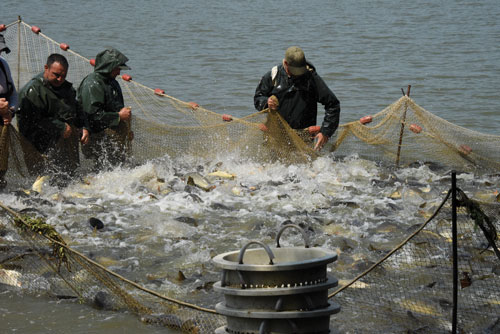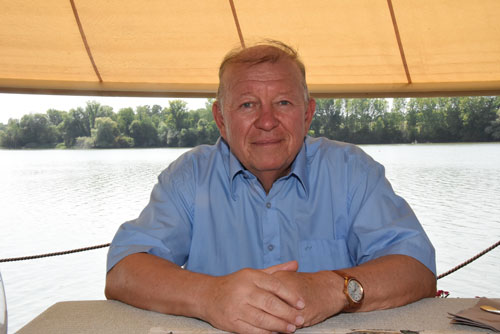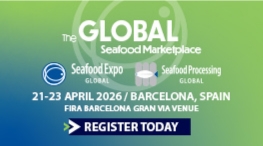This article was featured in Eurofish Magazine 5 2025.
Pond fish farming in Hungary is changing character. From producing primarily for consumption, fish is now cultivated increasingly for restocking and the ecosystem services ponds provide are becoming ever more important as the intensity of climate change impacts grows.
Tógazda Halászati Zrt., led by Dr István Németh, is one of the largest and most innovative freshwater aquaculture enterprises in Hungary. Based in Somogyapáti and with ponds spread across seven counties, mostly in the region of Transdanubia in western Hungary, the company operates on 1,800 hectares of water surface. Since its establishment in the early 1990s, it has grown into the biggest private fisheries company in the western part of Hungary, with a workforce of around 70 full-time employees and a network of seasonal workers who join during harvest periods.
The scale of operations is significant: over 80 ponds are used to rear a wide variety of species, from common carp and Chinese carps to predatory fish such as pike-perch and catfish. Tógazda controls the full production cycle, from fry and fingerlings through to market fish. It sells to domestic and EU markets, supplies the angling sector, and delivers directly to customers with its own fleet of trucks.
Balancing tradition and climate change
Hungarian pond aquaculture has traditionally relied on a three-year cycle. Fry are stocked in the first year when they grow into fingerlings, they grow to two-year fish in the second, and are harvested as market-size fish in the third. Historically, ponds were drained after harvest and refilled in spring with water from snowmelt. However, as Dr Németh explained, this method has become unsustainable. Winters now bring little snow, and springs often fail to provide enough water to refill ponds. Over the last ten years the number of dry periods has increased constantly. In fact, in the 100 ha pond in Somogyapáti, the water level is 1.5 m lower than normal due to drought. To adapt, Tógazda has changed its harvesting technology. Instead of draining ponds completely, they now harvest without releasing the millions of litres of water, which reduces water loss but adds cost and complexity. Summer harvesting requires an extra step to let fish empty their bellies of feed before they can be sold, whereas autumn harvesting – traditionally the main season – remains more efficient because fish are no longer feeding. Moreover, when draining the ponds the harvesting can be mechanised, while retaining the water calls for more manpower.

Fish being harvested from a pond. Climate change compels water retention strategies,
so the water is not drained from the pond making harvesting more labour intensive.
Climate change has also made fish farming riskier. Droughts and heatwaves have become more frequent, increasing pressure on stocks, particularly sensitive species such as pike-perch. The climate has changed faster than we were prepared for, Dr Németh says, adding that the company has had to rethink technology and management strategies to remain resilient.
Export markets are no longer what they were
Tógazda’s annual income from fish farming is about €5 million. But maintaining this revenue has grown increasingly difficult. Prices fluctuate heavily depending on subsidy policies in neighbouring countries and the imbalance creates an uneven playing field, especially in export markets. Traditionally, Hungary exported to Romania, Serbia, Poland and Austria. But these markets are shrinking. Polish producers no longer need to import Hungarian carp. Bulgarian farms, using faster growing intensive methods, are producing cheaper fish that undercut Hungarian exports. While Hungarian carp and pike-perch are recognised for higher quality, buyers in some markets prioritise lower prices. Cheaper fish from other countries is not the only threat – so is domestically produced meat. Pork, for example, is popular among consumers and is relatively cheap compared to fish. Although total production at Togazda has remained stable, climate impacts force changes in the mix of produced species; less pike-perch, a high value species, for example, and more carps. This squeeze on profitability is compounded by rising labour costs. To hire and retain staff, Tógazda must pay wages comparable with other employers, among them international companies. Seasonal workers are essential for autumn harvests, but attracting reliable labour has become increasingly challenging.
To counter shrinking margins, Tógazda has embraced diversification. Beyond fish farming, it manages 12,000 hectares of hunting land across several counties, offering hunting and wildlife tourism. As part of this activity it runs the Tógazda Safari Hunting Lodge in Somogyapáti, a lakeside retreat featuring international trophy collections, traditional cuisine and wine tastings, as well as lodges in other counties. These ventures reflect a strategy of multifunctionality: combining aquaculture with hunting, tourism, birdwatching and gastronomy to stabilise income. This multifunctional approach mirrors broader trends in Hungarian aquaculture. With limited subsidies and environmental constraints, many pond farms rely on side activities to stay profitable. Angling, in particular, has become a crucial market. Hungary has about one million registered anglers – roughly 10 percent of the population – and Tógazda sells around 35 percent of its production into this sector. Angling organisations and producers now cooperate closely, even agreeing on indicative prices to stabilise the market.
Environmental stewardship
Tógazda is also known for its environmental commitments. Ponds are managed without antibiotics or artificial fertilisers, instead using organic methods and Hungarian-produced feeds. Since March this year pond parameters (temperature, oxygen content, algae, etc.) have been continuously monitored by a sensor-filled buoy. Reed beds and aquatic plants are preserved, supporting biodiversity and providing shelter for waterbirds. Otters, a protected species, are accommodated by limiting disturbance during breeding seasons, while cormorants are controlled through non-lethal methods such as sound cannons. Dr Németh stresses the role of fishponds in water retention, biodiversity and climate mitigation. Covering some 27–30,000 hectares nationally, Hungarian fishponds not only produce food but also maintain wetlands, recharge groundwater, and support birdlife. He argues that subsidies should reflect these ecosystem services, especially given that monocultures such as maize fields receive more support despite offering far less biodiversity.
Despite its size and resilience, Tógazda faces the same uncertainties as the sector at large. Fish consumption in Hungary remains low – about one kilogram of domestic fish per person annually – while imports of salmon, hake and even smoked carp from Argentina continue to rise. Supermarkets have helped normalise year-round fish consumption, but imported marine fish often outcompete local species on price and convenience. Another concern is generational renewal. Many Hungarian fish farms were founded in the early 1990s, and their owners are now approaching retirement age. The younger generation is often reluctant to continue in a sector with slim margins and high risks. Dr Németh sees solutions in professional management teams that include not only biologists but also economists capable of innovating new business models.
A source of environmental and economic services
Nonetheless, he remains cautiously optimistic. Tógazda is investing in technology such as water quality monitoring systems, generators for electricity, and cranes which reduce the need for manpower. It has diversified revenue streams and maintained production volumes despite climate and market pressures. And the management does not rule out a cyclical improvement in climate conditions in a few years potentially resulting in more precipitation. More generally, Dr Németh sees the biodiversity role of fishponds increasing in the future as well as their contribution to water retention. Ponds retain scarce water, recharge the water table, and modify the microclimate for the better. Apart from these ecosystem services, fish farms provide employment and contribute to attracting tourists often to remote areas thereby boosting local economies. But he is also realistic that pond fish farming with its approximately 2,400 employees will never carry the kind of political weight that agriculture or angling does.









